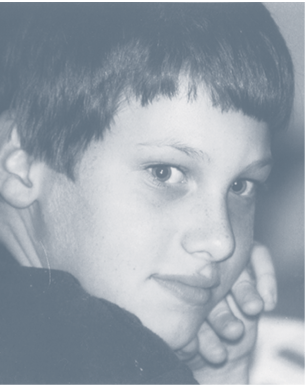
Megan Meier
Megan Meier was described by her mother as a bubbly and enthusiastic girl who loved hanging out with her dad. She was 13 and in 8th grade at Immaculate Conception School in Missouri. She had struggled with her weight and battled depression. However, she was reportedly upbeat in the fall of 2006.
Megan had recently struck up a relationship with 16-year-old Josh Evans on MySpace. He messaged her and asked to be her friend. Megan agreed and they corresponded for about six weeks. Then Josh turned on Megan, telling her that she was cruel and he didn’t want to be her friend anymore. He told her that the world would be a better place without her in it. Other postings found on Josh’s site read: “Megan Meier is a slut,” and “Megan Meier is fat.” Megan’s last message to Josh read, “You are the kind of boy a girl would kill herself over.” On October 16, 2006, Megan hanged herself with a belt in her bedroom closet and died the next day.
Megan had been friends with an elementary school classmate who lived down the street. They had been close but grew apart when Megan transferred to a different middle school. The friend’s mother, 47-year-old Lori Drew, wanted to know what Megan was saying about her daughter. So Lori and her employee, 18-year-old Ashley Grills, created a fake MySpace profile in order to check up on Megan and gain her trust. In the profile, Lori pretended to be the boy named Josh Evans.
It wasn’t until six weeks after Megan’s death that the fake profile became known. However, a police investigation did not lead to any charges against Lori Drew, because at the time there were no laws in Missouri that applied to this situation. Shortly after Megan’s suicide, her hometown passed a law that made cyberharassment a crime, but it was not an ex post facto law, meaning it did not apply retroactively. Missouri passed a state law in 2008 making cyberbullying a crime, but it also did not apply retroactively.
In May 2008, a federal grand jury in Los Angeles, California, indicted Lori Drew for violating the federal Computer Fraud and Abuse Act. Specifically, she was charged with conspiracy, fraudulent use of the Internet, and providing false information to MySpace when creating Josh’s account. When users become MySpace members, they agree to follow specific rules that include not soliciting personal information from anyone under age 18, and not using information gathered from the site to harass, abuse, or harm other people. If Lori were convicted, she could face up to 20 years in prison. Ashley Grills testified against Drew at trial and was granted immunity from prosecution for cooperating with the government.

How Would You Decide This Case?
There is no question that Megan’s suicide was tragic and may have been avoided. Assuming the final messages from “Josh” drove Megan to end her life, the case raises legal issues regarding free speech and liability for irresponsible Internet writings. Is it wrong or illegal to be cruel? Should you be held accountable for unexpected consequences of your postings, whether in a blog, chat room, or instant message? Where do you draw the line concerning your responsibility to others? What do you think about using someone else’s name or creating a fake profile to hide behind?
There are many reasons for remaining anonymous on the Internet. For example, many law enforcement agencies encourage “silent witness” participation in their crime-fighting work. Unless assisting with crime fighting in this way, should you be allowed to remain anonymous while online? The right to speak freely online is important to everyone, including users seeking refuge from abusive spouses, workplace whistleblowers, and government watchdogs.
What the Jury Decided
The charges against Lori Drew were based on the Computer Fraud and Abuse Act, which is a criminal law that carries penalties when violated. It usually applies to Internet hackers who illegally access accounts to get information. This was the first time it had been used to prosecute a person for sending harassing messages and fraudulently attempting to obtain information from a minor.
This was the nation’s first criminal cyberbully trial. It was tried before a jury of six men and six women in November 2008. After deliberating for six hours, the jury was hung (meaning no verdict was reached) on the conspiracy charge. Lori Drew was found guilty on the remaining three counts, which were reduced to misdemeanors. This changed a possible 20-year prison sentence to one year in jail and a $100,000 fine on each count. The sentencing court, however, overturned the jury verdicts and acquitted Drew of all charges. The judge said that her actions were not covered by the Computer Fraud law. The government appealed the dismissal of the criminal charges, and in November 2009 withdrew the appeal, ending the case.
How Does This Case Affect You?
The Internet is a valuable resource and a tremendous social gathering place. Like anything else, however, it can be abused. The suicide of Megan Meier and conviction of Lori Drew (even though it was later overturned) sends a message to all Internet users about lying and bullying and unintended tragic consequences. There is no way to know exactly what another person is thinking or feeling—even your best friend.
The bottom line: Words are powerful. Cruel words may even be fatal. Be mindful of this fact and stop to think before you speak, write, or hit “send.”
Megan’s mother, Tina Meier, started the Megan Meier Foundation (www.meganmeierfoundation.org) after her daughter’s death. Its mission is to promote positive change in response to bullying and cyberbullying. The pledge below appears on the foundation’s Web site.
Related Cases
State v. Nicole Williams (Missouri, 2008)
In one of the first cases prosecuted under Missouri’s 2008 law against cyberbullying, 21-year-old Nicole Williams was charged with harassing a 17-year-old girl. In an argument over a boy, Nicole allegedly left the girl threatening text messages. She referred to the girl as “pork and beans” and threatened her with rape. Nicole pleaded guilty to harassment and was sentenced in 2009 to two years probation and anger management classes.
“e-Thugs think they are a million times stronger because they can hide behind their computer monitor.”
—PEW Internet and American Life Project, 2007
In the Matter of Abraham Biggs (Florida, 2008)
Abraham Biggs was a 19-year-old college student with a history of depression. He was on medication and decided to end it all by taking a combination of drugs. Abraham did this in front of a live webcam audience over a 12-hour period in November 2008. Some viewers tried to talk him out of it, while other bloggers encouraged him to continue. Approximately 1,500 viewers watched the streaming video. When the police were finally called and they went to Abraham’s apartment, it was too late.
“[Online communications] are like the crowd outside the building with a guy on the ledge. Sometimes there is someone who gets involved and tries to talk him down. Often the crowd chants, ‘Jump, jump.’ They can enable suicide or help prevent it.”
—Professor Jeffrey Cole, University of Southern California, 2008
In the Matter of Rachael Neblett (Kentucky, 2006)

Rachael Neblett
Rachael was a friendly 17-year-old student at Bullitt High School in Kentucky. She was a cheerleader and excelled in gymnastics. She had a passion for lipgloss and sunglasses.
In the summer of 2006, she started receiving threatening emails at home. Rachael believed the sender to be another student because she knew where Rachael was during the day at school. Rachael didn’t tell her parents right away, but she did share the emails with her sisters and friends. The principal was notified and he and Rachael’s teachers kept an eye on Rachael. In September 2006, she received the following message:
“Meet me out front of school . . . and we’ll settle it there and honey you are not going to the hospital. I’m going to put you in the morgue.”
According to her father, Rachael was petrified. She stopped her daily activities out of fear and stayed home when not in class. Three weeks later she shot herself in the chest in her parents’ bedroom and died. The police investigation to identify Rachael’s cyberstalker continues. It is believed that someone was threatening Rachael through a fake MySpace account.
In an unexpected turn of events, six months after Rachael’s death, her close friend committed suicide. In April 2007, 16-year-old Kristin Settles, who was devastated by Rachael’s passing, hanged herself. She left a note asking that she be buried next to Rachael. Kristin’s story may be read on the Make a Difference for Kids Web site listed below.
In the Matter of Jeffrey Johnston (Florida, 2005)

Jeffrey Johnston
Jeff Johnston stood out not only because he was almost six feet tall, but because of his shoulder-length hair. He was growing it out to donate to Locks of Love, a charity for cancer patients. After breaking up with a girl when he was in 7th grade, he was called a stalker and was bullied online for the next three years. When he was in 8th grade, someone hacked into his online video game and filled it with nasty comments.
At age 15, Jeff wrote, “the world would never change” and “I’ll never get over 8th grade.” Not long after leaving these notes in his bedroom, Jeff hanged himself in his closet. Jeff’s death brought about Florida’s “Jeffrey Johnston Stand Up for Students Act,” which requires public schools to implement anti-bullying policies.
“A bully doesn’t have to be eye to eye to bully someone. Sometimes he or she gets into cyberspace and then there’s no place to hide from their torment.”
—Debbie Johnston, Jeff’s mother
In the Matter of Ryan Patrick Halligan (Vermont, 2003)

Ryan Patrick Halligan
Ryan was in middle school in Vermont. He loved acting and comedy. He was not athletic and struggled with his grades. When Ryan was 11, kids started picking on him at school. His parents let him take kickboxing lessons to build his confidence. While in 7th grade, Ryan confronted one bully and got in a few swings before the vice principal broke up the fight. Then he and the bully became friends for a short time until the bully turned on him by spreading online rumors that Ryan was gay.
During the following summer, Ryan instant messaged a girl he had a crush on. Later at school she told him she was just pretending to like him and that he was a loser. Not long after, Ryan waited for his family to go to sleep before he went into the bathroom and hanged himself. He was 13 years old.
Since Ryan’s death, his father, John Halligan, has become an advocate and educator regarding cyberbullying laws. At a conference on cyberbullying in November 2008, Mr. Halligan spoke to 300 middle and high school students. Jed, age 13, commented that, “After hearing Ryan’s story, it just goes to show how much one thing, one sentence, can do to hurt a family. Just like that.”
In the Matter of Ricky Alatorre (Indiana, 2008)
Ricky Alatorre was a heavyset 16-year-old who lived on his family’s farm in Indiana and did well in school. While Ricky was in English class in 2008, a classmate secretly took his picture. Soon a fake profile titled “The Rictionary” showed up on MySpace that claimed that Ricky was gay and loved dictionaries, and poked fun at his high grades at school.
“I was completely devastated,” Ricky said. “It’s one thing if it’s in my school paper because that’s contained within a small area. But when you put it on the Internet, you are opening up to everyone in the world.” Upon request, MySpace removed the profile from the Web.
“I had thought about suicide,” Ricky said. “It looked very welcoming at certain times.” With the help of his family and the school, Ricky is coping with more than the usual growing pains.
Billy Wolfe v. John Doe (Arkansas, 2008)
Billy Wolfe attended Fayetteville High School in Arkansas. As a 15-year-old sophomore, he put up with school bullies since he was 12. That’s when he received a call at home asking if he was interested in buying a sex toy. He told his mother, who reported it to the other kids’ parents. The next day Billy saw a list of 20 kids who wanted to beat him up.
Billy is tall and thin and has a learning disability. He likes the outdoors, racquetball, and girls. Over a three-year period he endured assaults at school, on the school bus, and in class. One attack was recorded on a cell phone camera and posted on the Internet. A Facebook page called “Everyone That Hates Billy Wolfe” invited others to beat up Billy. In response to this site, others were created like “Not Everyone Hates Billy Wolfe,” and “Not Cool, Billy Wolfe Haters.” Each of these sites drew hundreds of supporters.
In September 2008, Billy sued the school and assistant principal for failing to protect him from physical and online harassment. He alleged that the school did not discipline the students who bullied him. He was quoted saying he just wants “to get kids to leave me alone and stop bullying me.” Billy graduated in 2009. His lawsuit remains pending at the time of this book’s publication.
Hailee Wiggins-Ketchum v. Corona del Mar High School (2009)
Hailee was a 17-year-old senior at Corona del Mar High in California. In January 2009, she became the online victim of four varsity athletes at school. They posted a video on Facebook in which they threatened to rape Hailee in the back of a pickup truck, and then acted out how they would shoot her to death.
Hailee’s parents reported the threats to the school and the police. Little was done. The boys were suspended for a few days, and a few months later the school honored them for their athletic prowess. No criminal charges were filed. In the meantime, Hailee was forced to change her personal and school schedule to avoid contact with the boys.
Hailee and her parents sued the school district for allowing a sexist, homophobic, and intolerant atmosphere to flourish at the school. In September 2009, a settlement was reached. The school district agreed to write a letter of apology to Hailee. They further agreed to implement a training program for all school administrators, teachers, and students that focuses on the harmful impact of sexual discrimination and harassment.
Upon reaching the agreement, Hailee commented that, “I hope other students will learn from my experiences that it is possible to stand up for what is right and to prevail.”
Things to Think About
Do you think people are so desensitized by violent videos, computer games, television, and movies that watching a teenager slowly kill himself causes few to react? Is using a fake profile to harass or bully someone acceptable behavior? Do you have a friend who is being bullied, online or off? Do you feel any responsibility to get involved, or is it easier to pretend it’s nothing and everything will be okay? Do you realize that you can’t hide behind your computer screen—that a social networking site may either agree to or be court-ordered to disclose your real name? Think about these points and discuss them with friends and family.
Chapter 16: Further Reading and Resources
Bullying, No Way • www.bullyingnoway.com.au
Australia’s educational communities reach out to students with “talk out” opportunities, “chill out space,” and more.
Cyberbullying Video • www.youtube.com/watch?v=fNumIY9D7uY
This powerful video by Childnet International shows a boy who is being cyberbullied, how it affects his life, and how he gets help.
Ryan’s Story • www.ryanpatrickhalligan.org
Ryan Halligan was in 8th grade when online bullying lead to his suicide. Visit this memorial Web site for information and resources regarding bullying and suicide prevention.
SafeKids.com • www.safekids.com/family-contract-for-online-safety
Help establish Internet rules you and your parents can both agree on. Visit this Web site for example contracts.
Suicide.org • www.suicide.org
Resources, forums, and hotlines for suicide prevention, awareness, and support. For state, national, and international hotlines, click on “Suicide Prevention Hotlines.”

